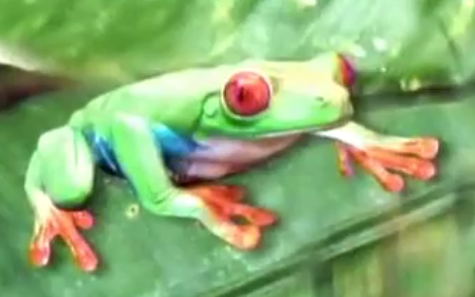Growing up, my Saturday mornings were filled with the vibrant colors and adventurous spirit of “Go Diego Go!” Watching Diego, the bilingual explorer, navigate the Amazon rainforest with his animal friends always sparked a sense of wonder in me. One creature that particularly captured my imagination was the red-eyed tree frog – a charming amphibian with a unique ability to blend seamlessly into its surroundings.

Image: dora.fandom.com
Beyond the animated show, these remarkable frogs have captivated audiences worldwide with their stunning beauty and fascinating adaptations. Their presence in “Go Diego Go!” brought them into the spotlight, making them both beloved characters and important ambassadors for rainforest conservation.
The Red-Eyed Tree Frog: A RainForest Jewel
The red-eyed tree frog, scientifically known as *Agalychnis callidryas*, is a species native to Central and South America. These frogs are arboreal, meaning they spend most of their lives in trees, making the lush rainforests their ideal habitat. Their striking appearance is a testament to nature’s artistry, featuring vibrant green skin, bright red eyes, and captivating blue feet.
Their red eyes serve a crucial purpose beyond their beauty. When a predator approaches, the red eyes open wide, startling the attacker and giving the frog precious seconds to escape. Their vibrant colors also act as a warning signal, showcasing their toxicity to potential threats. These natural defenses help them navigate the intricate world of the rainforest.
A Closer Look at the Red-Eyed Tree Frog’s Life
From Tadpole to Tree Dweller
Red-eyed tree frogs start their lives as tiny tadpoles, hatching from eggs laid in water-filled leaf axils or bromeliads. These tadpoles undergo a fascinating metamorphosis, developing limbs and lungs, eventually transforming into the adult frog we know. As the tadpoles grow, they feed on algae and other organic matter present in the water. Once they transition into frogs, they rely on a diet of insects, spiders, and other small invertebrates.

Image: mungfali.com
The Significance of Their Color
Their vibrant green skin offers excellent camouflage against the dense foliage of the rainforest. As daylight fades, their coloring shifts to a darker shade of green, providing superior camouflage in the shadows. This camouflage helps them blend seamlessly into their environment, providing protection from predators.
A Symphony of Sounds
Male red-eyed tree frogs are known for their distinctive calls, often described as a high-pitched “tweet” or “chirp.” These calls serve as a way to attract females for mating. The males use their vocal sacs, located under their throats, to amplify their calls. The females, in turn, are attracted to the loudest and most persistent calls, leading to successful mating.
A Vibrant Symbol of Conservation
The red-eyed tree frog has become a symbol of rainforest conservation. Their vibrant colors and captivating life cycle raise awareness about the crucial role rainforests play in our ecosystem. As deforestation and habitat loss threaten their survival, these creatures serve as a powerful reminder of the need to preserve these diverse and fragile ecosystems.
Trends and Developments in Red-Eyed Tree Frog Research
Research on red-eyed tree frogs continues to reveal fascinating insights into their adaptations and behaviors. Recent studies have shed light on the role of hormones in their color-changing abilities, demonstrating the intricate interplay between their physiology and environmental cues. Scientists are also investigating the potential of their toxins for medicinal purposes, highlighting the potential benefits of their unique evolutionary path.
The growing popularity of these frogs as pets has also fueled research into their captive breeding and care. This research is crucial for ensuring the ethical and responsible keeping of these amphibians, prioritizing their welfare and minimizing the impact on wild populations. Moreover, the rise of online platforms like YouTube and social media have led to a surge in interest and engagement with red-eyed tree frogs, providing educational resources and promoting awareness of their importance.
Expert Tips for Viewing and Protecting Red-Eyed Tree Frogs
Observing in Their Natural Habitat
For nature enthusiasts seeking to witness the beauty of these frogs in their natural habitat, it’s crucial to respect their environment and follow responsible viewing guidelines. Avoid disturbing their nests or disrupting their natural behavior. Always observe from a distance, using binoculars if necessary, to minimize your impact.
Supporting Conservation Efforts
Supporting organizations dedicated to rainforest conservation is critical in safeguarding the future of red-eyed tree frogs and their habitats. These organizations work tirelessly to protect these valuable ecosystems from deforestation, pollution, and climate change, ensuring the continued survival of these remarkable creatures.
Frequently Asked Questions
What is the lifespan of a Red-Eyed Tree Frog?
In the wild, red-eyed tree frogs typically live for 3-5 years. However, with proper care, they can live up to 10 years in captivity.
Are Red-Eyed Tree Frogs poisonous?
While not poisonous, red-eyed tree frogs produce a toxic substance through their skin that can irritate or cause discomfort if ingested. They are classified as being mildly venomous.
Why are Red-Eyed Tree Frogs important?
Red-eyed tree frogs play a vital role in their ecosystem. They control insect populations, serving as natural pest control agents. Their presence is a good indicator of the health of the rainforest, and their continued survival depends on the preservation of their habitat.
Go Diego Go Red Eyed Tree Frogs
Conclusion
The red-eyed tree frog’s captivating beauty and fascinating adaptations have made them a beloved symbol of rainforest conservation. Their presence in “Go Diego Go!” brought them to a wider audience, highlighting their ecological importance and sparking a desire to protect these vibrant creatures. As we continue to learn more about these remarkable amphibians, we can further appreciate their intricate world, promote responsible stewardship, and work together to ensure their survival for generations to come.
Are you fascinated by these amazing creatures? Let me know in the comments below! And be sure to share this article with others who might be interested in learning more about the red-eyed tree frog.





